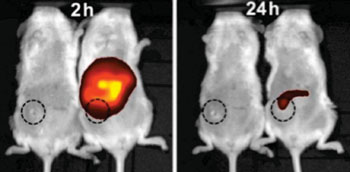Acid-Sensitive Nanoparticle Drug Delivery System Targets Cancer Stem Cells
By LabMedica International staff writers
Posted on 22 Jun 2015
A novel nanoparticle-based drug delivery system was designed to destroy the cancer stem cells that are responsible for tumor recurrence and development of drug resistance.Posted on 22 Jun 2015
Drug resistant cancer stem-like cells are responsible for cancer recurrence associated with conventional chemotherapy. To target this class of cells, investigators at The Ohio State University (Columbus, USA) developed a novel type of doxorubicin (DOX)-encapsulated polymeric nanoparticles.

Image: After two hours, doxorubicin-carrying nanoparticles accumulated in cancer cells (red and yellow) in mice (left) and destroyed most of the tumor within a day (right) (Photo courtesy of the American Chemical Society).
Although in use for more than 40 years as a primary chemotherapy drug, DOX is known to cause serious heart problems. To prevent these, doctors may limit the amount of DOX given to each patient so that the total amount a patient receives over her or his entire lifetime is 550 milligrams per square meter, or less. Furthermore, the necessity to stop treatment to protect the patient from heart disease may diminish the usefulness of DOX in treating cancer.
The surface of the DOX nanoparticles was "decorated" with chitosan, a natural polysaccharide that guided the particles to the CD44 receptors on the cancer stem cells.
Chitosan is muco-adhesive in nature, reactive (so it can be produced in many different forms), and has a positive charge under acidic conditions. This positive charge comes from protonation of its free amino groups. Lack of a positive charge means chitosan is insoluble in neutral and basic environments. However, in acidic environments, protonation of the amino groups leads to an increase in solubility. The implications of this are very important to biomedical applications. This molecule will maintain its structure in a neutral environment, but will solubilize and degrade in an acidic environment. This means chitosan can be used to transport a drug to an acidic environment, such as the tumor microenvironment, where the chitosan packaging will then degrade, releasing the drug.
Results published in the May 25, 2015, online edition of the journal ACS Nano revealed that the nanoparticle design strategy increased the apparent cytotoxicity of doxorubicin by six times in comparison to the use of the free drug for eliminating CD44+ cancer stem-like cells residing in cultured three-dimensional mammary tumor spheroids. They further showed that the nanoparticles reduced the size of tumors in a mouse orthotopic xenograft tumor model with no evident systemic toxicity.
The investigators concluded that further development of the nanoparticle system to target cancer stem-like cells with low systemic toxicity could provide a new treatment arsenal for improving the survival of cancer patients.
Related Links:
The Ohio State University













